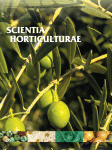Ver ítem
- xmlui.general.dspace_homeCentros e Institutos de InvestigaciónCIRN. Centro de Investigaciones de Recursos NaturalesInstituto de SuelosArtículos de divulgaciónxmlui.ArtifactBrowser.ItemViewer.trail
- Inicio
- Centros e Institutos de Investigación
- CIRN. Centro de Investigaciones de Recursos Naturales
- Instituto de Suelos
- Artículos de divulgación
- Ver ítem
A dichotomous key for the discrimination of the already known S-RNase alleles in potato species
Resumen
The potato species exhibit gametophytic self-incompatibility system controlled by a single S-locus withmultiple S-haplotypes. Each S-haplotype carries two genetically linked genes, S-RNase and SLF, controllingthe female and male specificities, respectively. In the style, the S-RNase gene codes for an allele-specificribonuclease that is involved in the rejection of pollen that carries the same S-haplotype. This gene hasfive conserved regions (C1–C5) and
[ver mas...]
The potato species exhibit gametophytic self-incompatibility system controlled by a single S-locus withmultiple S-haplotypes. Each S-haplotype carries two genetically linked genes, S-RNase and SLF, controllingthe female and male specificities, respectively. In the style, the S-RNase gene codes for an allele-specificribonuclease that is involved in the rejection of pollen that carries the same S-haplotype. This gene hasfive conserved regions (C1–C5) and two hypervariable domains located between C2 and C3 that play arole in S-RNase allele specificity. Presently, eight nucleotide sequences of S-RNase alleles from Solanumtuberosum and S. chacoense have been reported in potato species. In an effort to discriminate these S-RNase alleles and eventually detect new allelic variants, these sequences were analyzed by in silico PCR,using primers designed on the basis of four conserved regions, and were further examined by restrictionenzyme patterns. The development of the in silico approach led to the creation of a novel dichotomous keywhich was able to unequivocally identify the eight potato S-RNase alleles already known and eventuallydetect putative alleles when the size and/or the restriction pattern of the amplicons were different fromthose predicted. Experimental data validates the utility and efficiency of the dichotomous key
[Cerrar]

Autor
Marcellán, Olga;
Acevedo, Alberto;
Fuente
Scientia horticulturae 166 : 17-23. (13 February 2014)
Fecha
2014-02
Editorial
Elsevier
ISSN
0304-4238
Formato
pdf
Tipo de documento
artículo
Palabras Claves
Derechos de acceso
Restringido
 Excepto donde se diga explicitamente, este item se publica bajo la siguiente descripción: Creative Commons Attribution-NonCommercial-ShareAlike 2.5 Unported (CC BY-NC-SA 2.5)
Excepto donde se diga explicitamente, este item se publica bajo la siguiente descripción: Creative Commons Attribution-NonCommercial-ShareAlike 2.5 Unported (CC BY-NC-SA 2.5)

